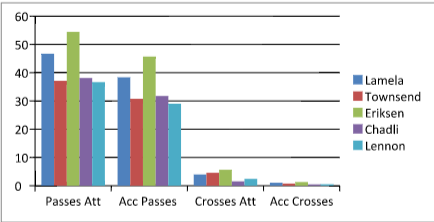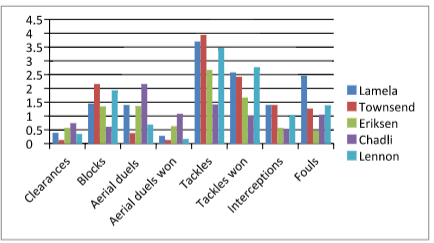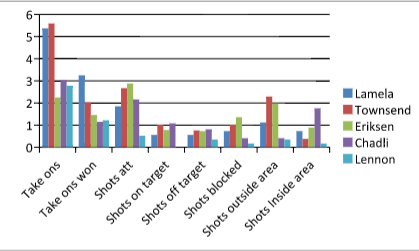On 1st January the transfer window opened and kick started a month of speculation and rumour. On the same day Spurs fans witnessed a morale boosting 5-3 home win over London rivals Chelsea, a game in which the team finally seemed to get to grips with Mauricio Pochettino’s exciting brand of high pressing and attacking football. Rather surprisingly, Andros Townsend started and scored from the penalty spot. I say surprisingly because, despite that being his second start in consecutive Premier League matches, prior to this he had largely been overlooked by the Head Coach in this competition. At the time of writing the pacey winger has only started 3 PL games in total, being used as a substitute in 4 more, and has made most appearances this season in the much maligned Europa League (5). This suggests that Pochettino does not have confidence in his abilities to perform the duties he expects week in week out in the Premier League. While local hero Harry Kane is receiving all the plaudits for his recent performances, Andros Townsend is struggling to justify his place in the team and may be on his way out of the club.
This got me thinking about how much Townsend has managed to adapt to Pochettino’s style, grow as a player and change the way he plays. My gut told me that the personality of his play is true today as it ever was last season; he tends to shoot from distance but not score, take players on and cross to no-one and generally get dispossessed. But I wanted to check out the data so I decided to look at Townsend’s performance statistics for games played so far in the 2014/15 season (PL and EL games only) and compare them with the performance statistics for games played from the 2013/14 season using variables measured by WhoScored.com.
To explain how I went about doing this and why is rather technical. If any readers are interested however I am currently writing a short companion piece on using real world statistics with football so keep an eye out for this.
For now though, basically what I wanted to do first was get a sense of what Townsend’s ‘normal’ performance data looked like based on his performances last season. This would give me something to compare this season’s performances with. Now I could simply take his total scores or average scores for each performance variable but this wouldn’t tell me whether the differences are statistically meaningful. Instead, I need to understand what his normal ‘spread’ was last season to then determine how typical this season’s score is. For instance, did he make 20 passes in every game? Or did he sometimes make 35 and sometimes make 5? And if so how many times did he get these numbers. This is what I mean by spread. For those not familiar with statistics, there is a numerical way of describing this spread and it’s called the Standard Deviation. With a Standard Deviation I can make certain assumptions about the data like using it to calculate cut-off points that represent the point where a performance statistic is considered typical or not. What I can then do is compare a single performance score with this cut-off value to see whether meaningful change has occurred.
To calculate the Standard Deviation however you need a series of values. So, I painstakingly reviewed every game Townsend played in the 2013/14 season in the Premier League, Europa League and one game in the League Cup Semi Final (data was not available for earlier cup games). For each game I noted the statistical data for a wide variety of defensive, offensive and general performance variables (e.g. Passes Attempted, Shots on Target, Loss of Possession). I then standardised each score by dividing it by the number of minutes played and multiplying this by 90. This converted it into a ‘per 90 minute’ statistic. This technique generally works well but in situations where a small amount of minutes are played there is a risk of overinflating the frequency of certain events happening (e.g. if he played 10 minutes and scored 1 goal, this would create a standardised value of 9 goals). This would create problematic outliers that would have a dramatic impact on the spread so I therefore only included games where he played >60 minutes to limit this effect. Eighteen games out of the 29 games he played in were suitable to use which equated to 1479 minutes; enough to get a decent sense of his ‘normal performance’ that season. To create the cut-off points for each variable I calculated the Mean average standardised score, calculated the Standard Deviation and then set them at +/- 1.96 Standard Deviations away from the Mean (1.96 is the conventional number of Standard Deviations to use as it equates to 95% of a normally distributed sample). This gave me an Upper Cut-off and a Lower Cut-off which could tell me whether he has meaningfully improved or deteriorated in his performances.
I then needed performance statistics for the 2014/15 season so far. As I did not need to know the spread this time I could simply use the standardised ‘per 90 minutes’ scores as provided on WhoScored.com based on matches played in the Premier League and Europe League (up to and including games played on 1st January). This was calculated by using totals (total of variable/ total minutes played * 90) so did not have the same problems as before with over inflation.
Essentially, with all that set up, if the 2014/15 averages were within the two cut-off points then I could conclude that little to no change had occurred. However if the averages were beyond the cut-offs then I could conclude that the difference was meaningful and he had made significant changes to his game (either for better or worse). So what did I find?
Below I’ve combined the variables into groups that best describe particular attributes/ roles. For each I’ll discuss in what ways Townsend has changed and then how his 2014/15 performance statistics compare with the team mates he is rivalling for a place in the starting line-up to put his scores into perspective.
General Game Effectiveness
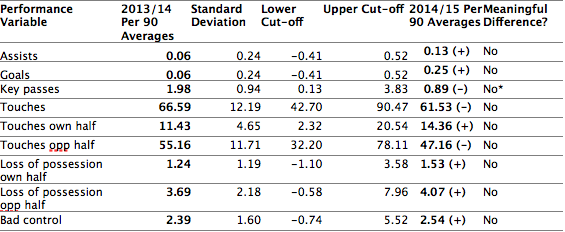
Table 1: Comparison between 2013/14 and 2014/15 General data, with 1.96SD cut offs to show meaningful change
As you can see from Table 1 Townsend has not made any meaningful changes in terms of positive impact on games. He has made small improvements to his Assists and Goals statistics (as noted by the + in parentheses) but actually the number of Key passes per 90 minutes has reduced (the * denotes that this difference whilst not >1.96SD was actually >1SD so is a notable change). With 61.53 Touches per 90 minutes he is involved in games enough to expect a better impact. Interestingly he’s having slightly more Touches in his own half this season and less Touches in the opponent’s half which might indicate a more defensive sensibility. Elsewhere he is still Losing possession 5.6 times and showing Bad control 2.5 times every 90 minutes. It is pretty disappointing that he has not managed to eradicate this part of his game.
So how does he compare with his fellow team mates who can play in his position? Basically not well, as illustrated in the below graph.
Townsend (in red) has the highest rates for Loss of possession and Bad control per 90 minutes when compared to his team mates. Conversely he has the worst rates for Key passes. He’s not the worst in terms of Assists or Goals but both Chadli and Eriksen provide a more potent goal threat whilst Chadli, Lennon and Lamela all offer a better rate of assists. Overall, in terms of the first team players available to Pochettino in the attacking midfield positions, Andros Townsend has had the least/worst impact.
Passing Productivity
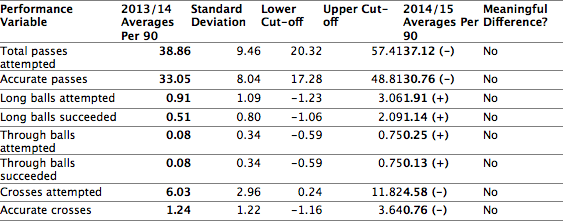
Table 2: Comparison between 2013/14 and 2014/15 Passing data, with 1.96SD cut offs to show meaningful change
Townsend’s passing statistics show a similar lack of change and no performance variables are meaningfully different. So far this season he’s attempted a similar number of Total passes per 90 minutes with a slight decline in accuracy shown. There also seems to be slight improvements to his Through ball and Long ball performance with a slight decline in his Crossing. For me this final point is the major disappointment because as a wide attacking player he really needs to perform at a better rate of less than 1 accurate cross every 90 minutes.
How this compares to his team mates is illustrated in the graph below.
Townsend actually compares well to Lennon and Chadli in regards Passes attempted and Accurate passes whilst Lamela and Eriksen stand out amongst their peers. Earlier I bemoaned the poor quality of Townsend’s crossing but here we find that he is more accurate per 90 minutes than both Lennon and Chadli although the difference is minimal. Maybe this suggests a team problem with no-one getting into the middle enough and/ or doing enough to get on the end of the crosses. Eriksen, incidentally, is the most prolific and accurate crosser. Overall, it would be harsh to suggest that Townsend is not at least competing in regards Passing and Crossing. With Eriksen playing in the No.10 position and Lamela on one flank, Lennon, Chadli and Townsend offer Pochettino about the same in terms of general passing productivity.
Defensive/pressing Productivity
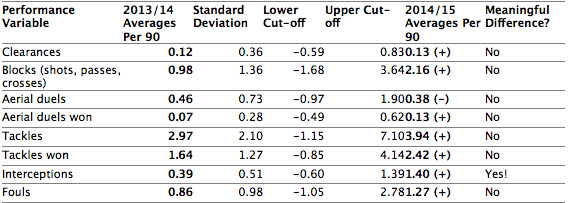
Table 3: Comparison between 2013/14 and 2014/15 Defensive data, with 1.96SD cut offs to show meaningful change
Finally we have a meaningful difference and it comes in the form of Interceptions. So far this season Townsend is averaging at 1.4 Interceptions per 90 minutes, up from 0.39 last season. Although this doesn’t seem like much of a difference the relatively small Standard Deviation (0.51) means there was very little variance in his rate of Interceptions last season. Although this was the only performance variable that showed a big enough difference there were small improvements to his all-round defensive game. This might indicate that actually Townsend is attempting to implement Pochettino’s tactics of pressing from the front.
However, are his fellow team mates adapting better than him?
This is where we find that whilst Townsend offers very little in the way of Aerial duels or Clearances (neither of which you would expect from an attacking wide player to be fair) he demonstrates the best rates of Tackles (both attempted and won), Blocks (shots, passes and crosses) and Interceptions per 90 minutes when compared to all his rivals so far this season. Lamela and Lennon both Block and Tackle well but they typically concede more Fouls whilst doing so. Overall, this suggests that Townsend’s meaningful increase in Interceptions has just added to the strengths he already had in this area when compared to his more attack minded team mates. Maybe this is why recently Pochettino has preferred to play him in Premier League games against tougher opposition (e.g. Man United and Chelsea) where his speed and defensive prowess are more likely to be needed.
Offensive Productivity

Table 4: Comparison between 2013/14 and 2014/15 Offensive data, with 1.96SD cut offs to show meaningful change
Whilst there are no performance variables that have changed enough to be meaningful, there is a fascinating trend. Townsend’s offensive productivity has generally weakened with the only variable showing an increase being the number of Shots from inside the area. He’s still more often than not shooting from outside the area and those shots are likely to be blocked just as much as on target, but it seems as though Pochettino may be encouraging a more restrained performance. This is perhaps seen most in the decrease in the amount of Take on’s (dribbles) he is attempting (remember the * denotes a difference > 1SD so is notable). Presumably these changes are a result of the increased focus on pressing and defending.
But how do his performance statistics compare to the others?
Despite the trend, the classic Townsend playing style is still apparent when we compare him to the others. He and Lamela are far more likely to attempt to dribble past someone during 90 minutes with the Englishman being less successful than his South American friend. Given Lamela’s better Assist rate per 90 minutes however he would be preferred to Townsend in this regard. Townsend has a similar Shots attempted rate to Eriksen and is unsurprisingly the person most likely to shoot from outside the area. I would have thought that he would have also had the highest rate of Shots blocked but this honour is Eriksen’s. In fact Eriksen’s and Townsend’s general shooting statistics are quite similar but as Eriksen is much more effective in front of goal this confirms Townsend’s unproductivity.
So overall my analysis has arguably highlighted several things of interest. Firstly, whilst Townsend is making significantly more Interceptions per 90 minutes this season compared to the last, he has not yet been able to meaningfully change the rest of his playing style. This is characterised by still being inefficient in front of goal, shooting often and from distance, wasteful and sloppy in possession, and less productive down the flanks in regards crossing, take ons and key passes. It is for this reason that his team mates (especially Chadli, Eriksen and Lamela) tend to start ahead of him. Secondly, despite the first point, there are small signs that Pochettino is starting to have an influence on him and he is doing all those wasteful things less often. Thirdly, and perhaps more importantly, he is actually more effective than others at tackling and blocking play which are critical attributes in performing the high press. This suggests that whilst others might be more effective and productive in terms of goals and assists, when Townsend is on the field he is better able to stop the opposition from playing and break down play enough for the more efficient players to do what they do better: set up and score goals. Turns out that Townsend brings something to the squad that the others do not and this perhaps means that he is less likely to be leaving White Hart Lane after all.
What do you make of the analysis? Do you agree that Townsend offers something different or should Spurs take the first sizeable transfer bid?
Psychobob
Latest posts by Psychobob (see all)
- Countdown to the Spurs 2015/16 Season…. 1 Day - August 7, 2015
- Countdown to the Spurs 2015/16 Season… 2 Days - August 6, 2015
- Countdown to the Spurs 2015/16 Season… 3 Days - August 5, 2015


